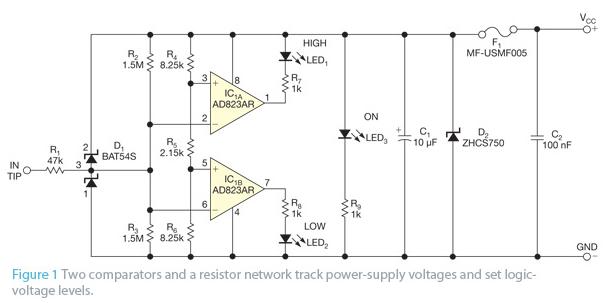

Industry News
Logic Probe Adopts Two Comparators
Published:2011/8/25 5:25:00 Author:Amy From:SeekIC
Measurement instruments should not affect the circuits. For instance, a logic probe must suitably detect logic levels, and it should not put undue loads on the test circuit. The logic probe must set thresholds on automatically checking logic levels, relying on the supply voltages of the ICs it is checking.
The previous logic probe has loading problems (Reference 1). Its thresholds do not adequately depend on the supply voltages of the ICs it is checking. After analysis, you will discover that the circuit can have an input-current range of 50 to 80 μA. Unfortunately, CMOS ICs have input current as low as ±1 μA. For instance, the HE4000 family of logic ICs has input currents of ±0.1 to ±0.3 μA. Connecting the referenced logic probe to input pins of these ICs loads the circuit under test and distorts the waveforms to the point at which you may not be able to see some problems, such as glitches, on an oscilloscope.
Figure 1 is an alternative logic probe for ICs of the 74HCxx family. It includes comparators IC1A and IC1B. Not every comparator will work properly in this circuit. The comparator must operate with minimal supply voltages, and it must have low input leakage current. The Analog Devices AD823AR or an equivalent comparator is a good choice. 
Comparators IC1A and IC1B check logic-high and -low levels, respectively. The resistor-divider network comprising the 1%-tolerant, surface-mount, size-0805 R4, R5, and R6 resistors sets the voltage levels, which vary with the power-supply voltage. Connect the probe circuit to the same power supply that you use to power the circuit under test, allowing the comparator voltages to track the circuit’s power supply. Green LED1 and red LED2 indicate logic-high and -low levels, respectively. If the input voltage is between those levels, neither LED will illuminate. Table 1 highlights the logic-level voltages for the 74HCxx family of ICs, and Table 2 shows the voltage levels for the 4000 series ICs. 

The input current of the AD823AR is less than ±3 μA at a drain-to-drain voltage of 5V, ±6 μA at a drain-to-drain voltage of 10V, and ±9 μA at a drain-to-drain voltage of 15V. You can reduce this current by increasing the value of resistors R2 and R3, which are 1.5 MΩ in Figure 1.
The network comprising R1 and D1, two BAT54S Schottky diodes, protects the logic-probe circuit from overvoltage at its input, from ESD (electrostatic discharge), and from signals of negative polarity. Yellow LED3 indicates when the logic-probe circuit and the circuit under test start up. The yellow LED is useful if you connect the probe to the circuit under test with crocodile clips. This approach ensures that both the probe and the test circuit are always on. D2 and resettable fuse F1, an MF-USMF005, which has a hold current of 0.05A and which comes in a surface-mount package, protect the probe circuit from improperly powering up. Tantalum capacitor C1, in size A or B, and ceramic capacitor C2, in size 0805, prevent the test circuit from influencing power for the logic probe. R1 minimizes the influence of input capacitance on this logic probe.
The logic-level thresholds automatically depend on the supply voltages (tables 1 and 2). This logic probe can be used with other ICs. The value of R6 can be selected freely. Using R5=VH/(VL/R6)–R6 and R4=VDD//(VL/R6)−R6−R5, the value of R5 and R4 can be figured out. VH is the threshold for checking the high logic level for the chosen supply voltage, and VL is the threshold for checking the low logic level for the chosen supply voltage.
Reprinted Url Of This Article: http://www.seekic.com/blog/IndustryNews/2011/08/25/Logic_Probe_Adopts_Two_Comparators.html
Print this Page | Comments | Reading(2390)
Article Categories
New published articles
· Imagination works with TSMC to develop FinFET process
Author:Ecco Reading(33516)
· XMOS pushes event-driven MCUs with lower price
Author:Ecco Reading(3534)
· Intel brings upgraded 32-nm SoC for smartphones
Author:Ecco Reading(3250)
· Micron pushes TLC 128-Gbit NAND flash
Author:Ecco Reading(3816)
· Intel will stop supplying desktop motherboards
Author:Ecco Reading(5341)
· Processor market was expected to regain strength in 2013
Author:Ecco Reading(3318)
· It was reported that TSMC sales fall steeply
Author:Ecco Reading(3474)
· Cisco, NXP work with auto wireless startup
Author:Ecco Reading(3620)
· Micron was impacted by manufacturing glitch
Author:Ecco Reading(4017)
· China can make 22-nm transistor by themselves
Author:Ecco Reading(3819)
· Chip market rebound is coming, according to survey
Author:Ecco Reading(3760)
· Sony, Toshiba will spend more on chips, iSuppli reports
Author:Ecco Reading(3790)
· Qualcomm becomes the 13th company to join NFC Forum board
Author:Ecco Reading(6103)
· TSMC increases building work for FinFET fab
Author:Ecco Reading(3778)
· TI plans to cut 1,700 jobs in OMAP shift
Author:Ecco Reading(4587)